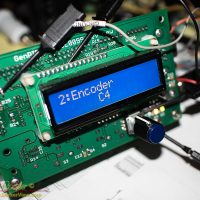The rotary encoder is a popular input device for many microcontroller devices. A knob that can be used to increase or decrease a setting with a nice tactile click for each increment. You can even get an integral pushbutton, just rotate for the setting then press the same knob to enter. With some clever programming you can create a one device user interface using only the encoder.

I have integrated a rotary encoder in the GenPIC utility board. With the combination of an LCD display and the rotary encoder you have all the ingredients for a functional user interface arranged neatly for a panel mount unit.
In the past I have simply set an interrupt to fire on the edge of one channel, then sampled the opposite channel to detect the direction. With the addition of a small delay to debounce the result. This worked well in previous devices, but this time I encountered trouble, the direction sampling was erratic, the value going up when it should have gone down and vice-versa.
Breaking out my logic analyser I found out why, this particular encoder proved to be somewhat noisier than I had seen in the past, with notable periods of bouncing signals.

